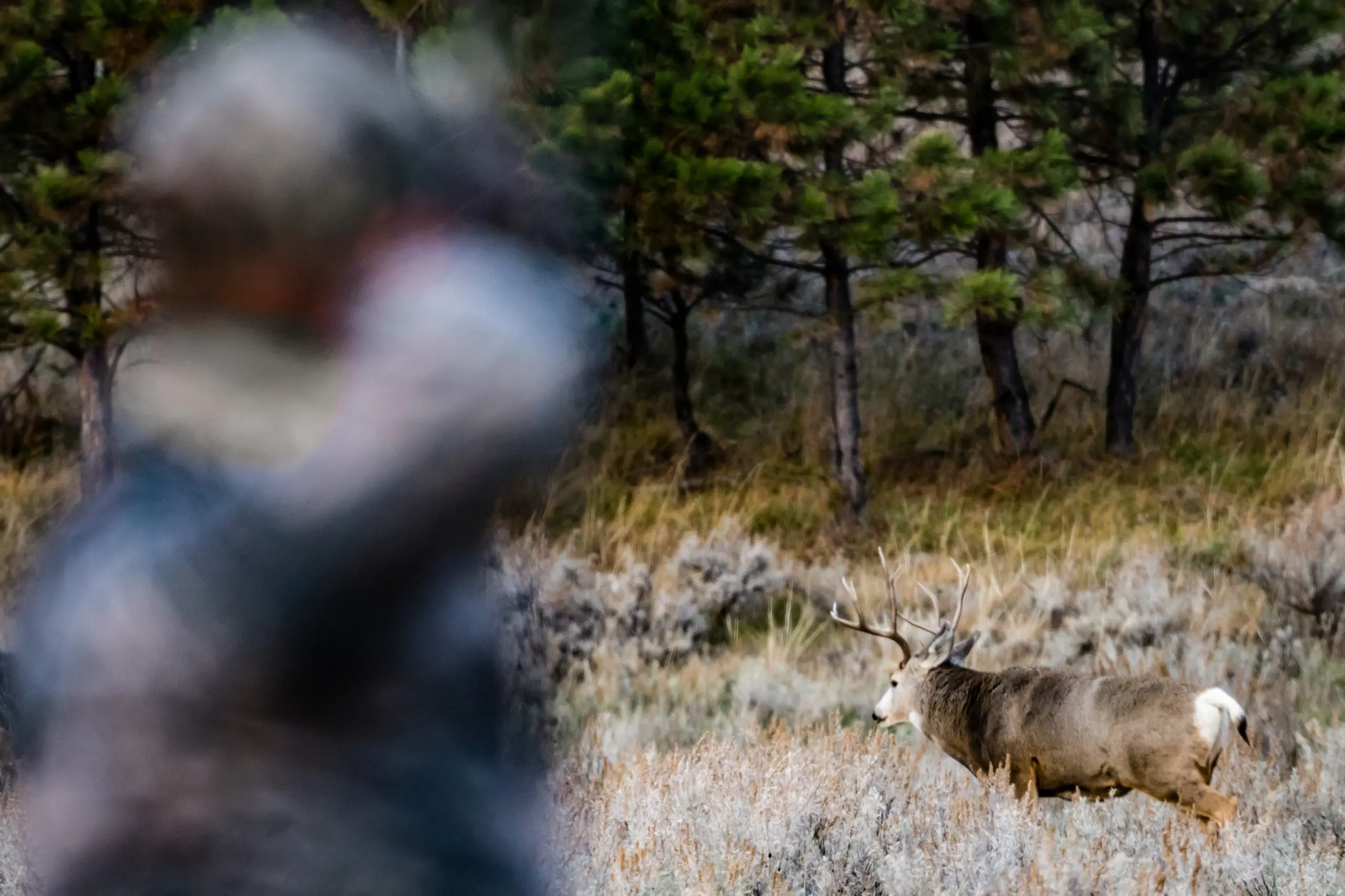
NOTICE: Certain links on this post may earn a commission for Western Hunter Magazine from Amazon or our other affiliate partners when you make a purchase. Thank you for your support.
Shoot Better Now
Shot-making secrets and the mental game
Your ability to make a good shot when it counts is the most important skill you can develop as a bowhunter. The guys that notch their tags year after year make good shots under pressure. There are a hundred other factors that also contribute to their success, but the only thing that every successful bowhunt has in common is a well-placed arrow.
All the planning, research, scouting, and decisions made during a bowhunt culminate at the shot opportunity – if you don’t finish the job, everything you did to get there was for all for naught.
So, what is required to consistently make effective (lethal) shots?
- A well-tuned and matched bow and arrow combination that is sighted accurately, fits the shooter well, groups broadheads consistently, and produces reliable penetration.
- A precise, angle-compensated range to the animal, and using the correct sight pin.
- You must control nerves and maintain spatial and situational awareness to collect and process info and react appropriately as the opportunity develops.
- You must anticipate the best opportunity to draw and be patient for a good shot angle.
- You must select an aim point offering a clear path to the vitals with the best potential to kill humanely (compensate for wind and “string jump” in the aim point).
- You need to draw and hold the aim comfortably within the vital region until the shot fires, while monitoring and maintaining the sight level.
- Your shot execution and form under pressure must be consistent with your normal practice shots regardless of terrain, shooter position, and time held at full draw.
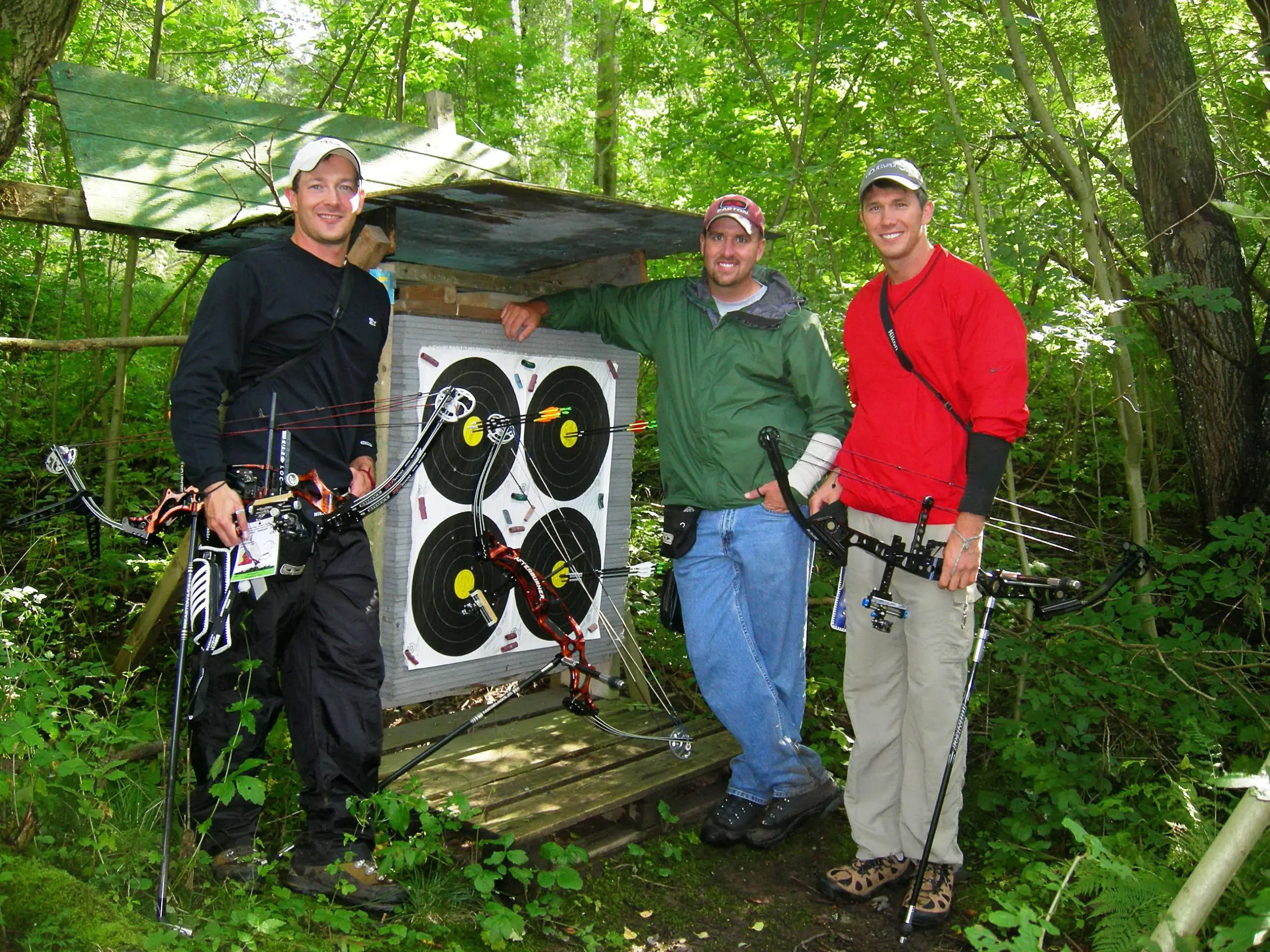
I blew a golden opportunity at the first buck I ever had the chance to take with my bow. I made a perfect stalk and had him right where I wanted, but I never got a shot. There’s no doubt that deer is still the largest typical muley I’ve ever seen. Failing to kill him was both traumatic and intensely motivating. That devastating failure was the impetus for my archery career. I was hooked on bowhunting after the experience, but also knew I had to get serious about archery to make the most of future opportunities.
I upgraded my equipment and put a lot of effort into becoming a better shooter in the years that followed. I got to know the best archers in my area and immersed myself in competitive shooting.
As I progressed and gained more bowhunting experience, my bowhunts were often successful. I harvested a lot of nice animals and made dozens of good bowhunting shots over the next two decades. But despite massive improvement as an archer, I still messed up some opportunities at unbelievable trophies. After a lot of soul searching, I finally realized a fatal flaw in how I was practicing and preparing for bowhunting the entire time.
It’s funny how something so obvious can be so easily overlooked. Even though bowhunting and target archery have so much in common, practicing for one doesn’t necessarily prepare you well for the other. I honestly thought I was doing everything I could to improve as a bowhunter. When I look back now, I feel like a baseball player who spent all his time at the golf course driving range expecting to improve his batting average.
I worked extremely hard to become a good target archer and I have zero regrets about that. I love competitive shooting. The skills I developed through target archery have been a big part of my bowhunting success. I believe every bowhunter can benefit from competitive shooting.
However, the way I practiced for tournament archery didn’t prepare me well for some of the unique challenges bowhunting presents. If I had recognized those elements and made a few tweaks to my practice sessions and mental game, my taxidermy collection would likely have several noteworthy additions.
What are the right things to practice? Let’s start with five things most bowhunters rarely do.
- Log your practice sessions in a permanent notebook.
- Change your mindset and place all your emphasis on your first practice arrow. It’s the ONLY one that matters when bowhunting.
- Scores don’t lie. Shoot and record scores. Use them to compete against yourself.
- Use blank bale practice to get in touch with what a perfect shot “feels” like.
- Develop a mental game you can merge into your shot routine. This will guide your execution, initiate focus, and enhance your situational awareness before a shot opportunity.
Write it Down!
One of the best tools you can have if you’re serious about becoming a better shooter is a logbook. A small, staple-bound notebook is the best option. Rite in the Rain No. 391 or Rhodia’s 6”x8” line-ruled notebooks are perfect. The compact size easy to pack around at the range or in your bow case.
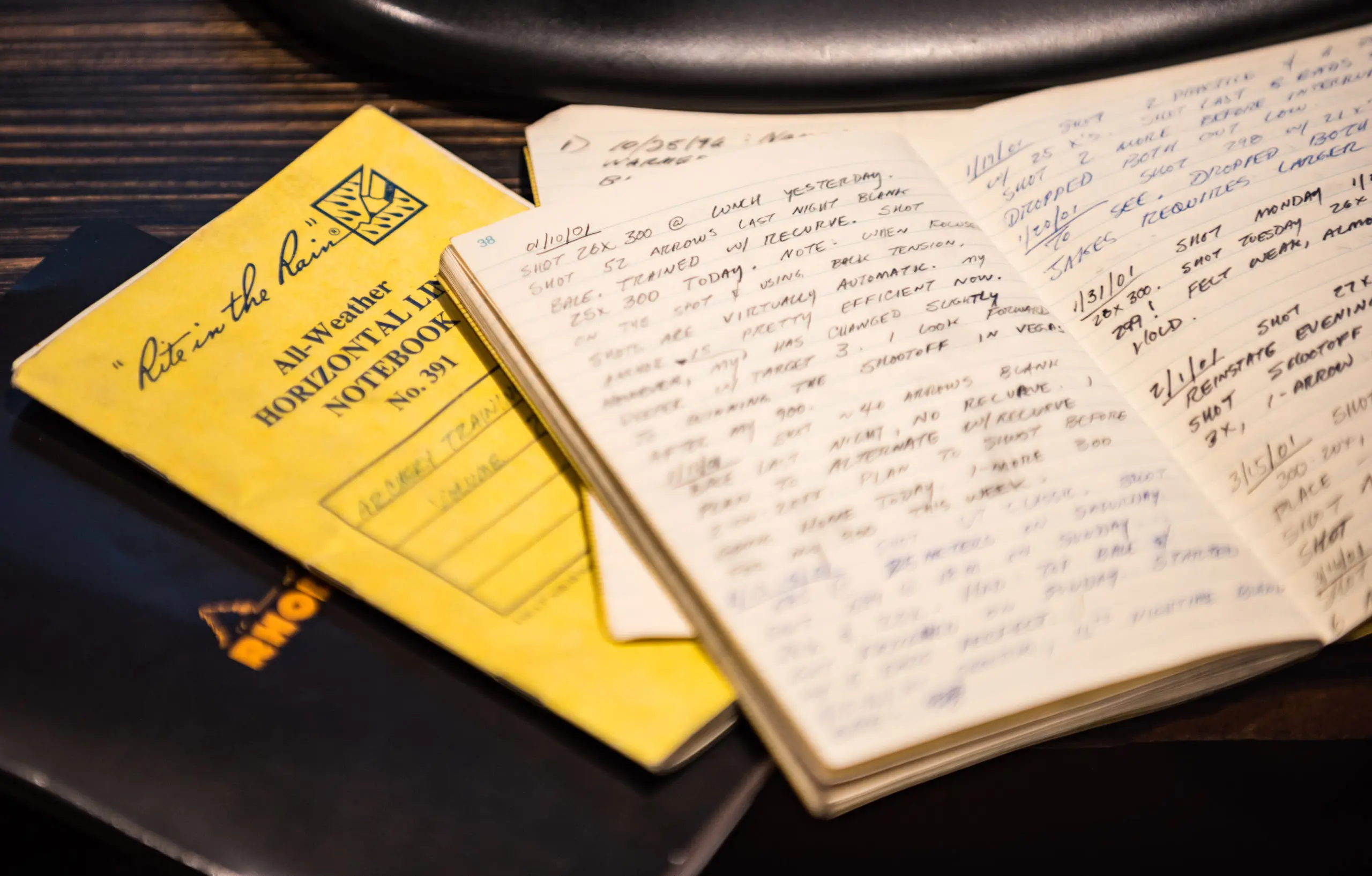
I have shooting logs dating back to 1996 in Rite in the Rain notebooks that are still in great condition. It’s both nostalgic and useful to look back on how I was training, the scores I was shooting, and the equipment I was using at various stages in my progression.
Use your logbook every time you shoot. Record dates and take notes on anything that affects your shooting. Write your goals and things you need to work on in a positive voice and make a practice plan that will ensure you reach them. Track scores and note your progress. Write about how you felt that day, what conditions were, and what you plan to do or change between now and the next practice session. Record tournament preparations, schedules, and results if you compete, even if it’s just among friends. Every time you make a change to equipment or form, make a note and track how it affects you, your form, and how the bow feels and performs.
When starting to prep for the next hunting season, I like to use 5-spot NFAA indoor targets. They’re cheap, easy to find, and ideal for practice at 20-yard ranges.
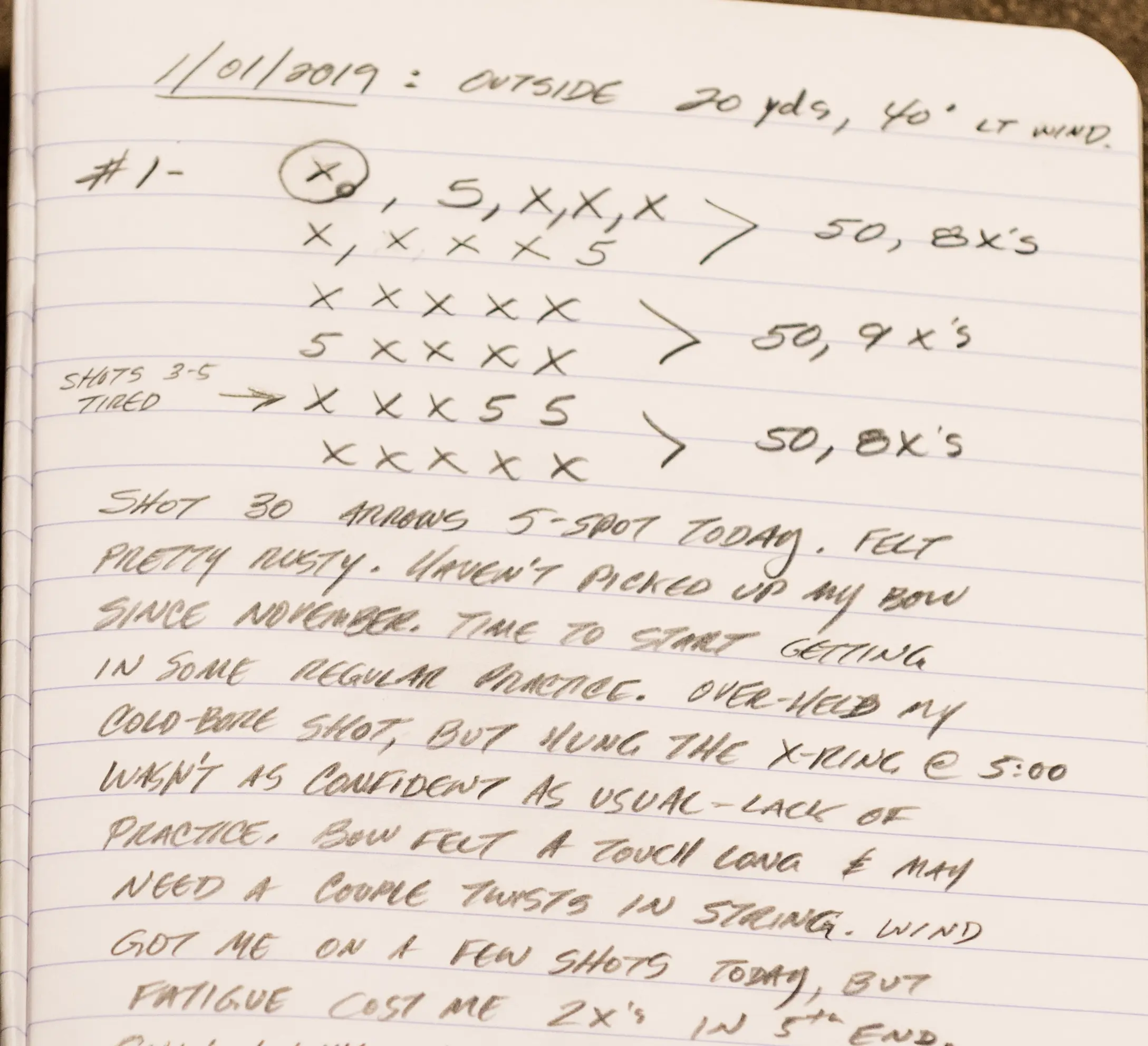
I like to shoot five arrows instead of only three on a “Vegas” 3-spot. You’ll spend more time shooting and less time walking. Shooting five arrows in a row can feel a little rough when you haven’t shot for a while, but it will make you stronger.
Buy a stack of targets so you can record a score on a clean target every time you practice. You can switch to a larger outdoor target or switch to a 3D target when it warms up and it’s time to shoot farther.
It’s important to shoot 3D’s at various angles when season approaches so you get accustomed to aiming at an animal as opposed to a spot. If you don’t have access to 3D targets, paper silhouettes are a decent alternative.
First Time’s a Charm!
Every time you shoot, make sure the very first arrow you shoot feels as important as if it was aimed at the trophy of a lifetime. Make it count by recording that shot front and center at the top of every logbook entry with a sketch of the impact. Go ahead and shoot the rest of your arrows and score them in the order you shoot them.
Drawing a picture of your first arrow for ten shooting sessions might tell you something important about your “cold-bore” shot as they refer to it in rifle shooting. If you consistently shoot high or left or low on that first shot, you’ll be able to see that trend in your log so you can work on identifying the cause and fixing it, or aim off to compensate as most rifle shooters do.
Practice the cold-bore shot several days per week if possible, especially leading up to a hunt. You’ll be surprised how much more comfortable you feel the more you focus on it. If you are able to shoot at home, you can shoot these cold-bore shots morning and evening, and several times per day on a weekend with a couple hours in between.
Learn to pull your focus and form together when your muscles are tight and your mind has been focused away from shooting. That’s the most important lesson in cold-bore shooting drills. Make this exercise part of every shooting session, year-round, and you’ll be more comfortable and confident on your next bowhunting shot.
This is the most overlooked difference between training for bowhunting and target archery. A pro archer would never purposely go to an archery tournament and launch their first arrow of the day for score, yet that’s exactly what you’re forced to do when bowhunting, so you’d better be good at it.
Who’s Keeping Score?
It’s important to track scores. I can look back in my practice logs and see progress over years of time just by looking at these tell-tale markers. You’ll be able to spot times when you were in a slump, and times your shooting jumped up a notch. When you see those things, your notes will often reveal what you were doing right or wrong at the time. Even if you never plan to compete, scoring a target is still the best measuring stick to see if you’re getting better, staying the same, or shooting worse.
If it makes you nervous or you find it frustrating to keep score, those are good things to use as motivation and learn to overcome. Don’t shy away from the truth – bad scores and frustrating days at the range are telling you something. Your scores may indicate you need to practice more or work on a specific issue that’s holding you back. If you have trouble aiming at a dot, are you going to have trouble if there’s a spot of mud on the perfect aiming point on a bull elk? Don’t avoid it…fix it!
A Blind Squirrel Always Finds the Nut
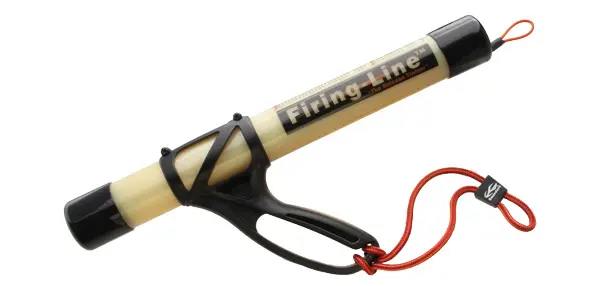
If you want to make big improvements, you need to shoot 3–5 days/week, but you don’t necessarily need to go to the range every time. I made the most progress with my form and muscle memory by shooting thousands of arrows at a blank target bale a few feet away with my eyes closed. I recommend blind/blank bale training to all archers. It’s the best way to learn how to “feel” your form, and “feel” a perfect release and follow through.
It’s nearly impossible to develop that sense while aiming and trying to shoot for score. You can also shoot a lot of arrows in a short timeframe, allowing you to increase repetition while maintaining or reducing time required. Blank-bale training is one of the secrets to rapid improvement and most professional archers I know use it.
Saunders Archery makes a release trainer called the Firing Line that is essentially a string connected to a grip. You can add weight to make it mimic your bow. This another way to get valuable practice and repetition with your release and form, away from the aiming process.
Build a Big Triangle
Great shooting is attributable to thousands of factors, but they can be generally lumped into three basic categories: physical, mental, and equipment. When all three categories are up to snuff, you can expect your shooting to be at its best. If you’re weak in any of these areas, your shooting is compromised.
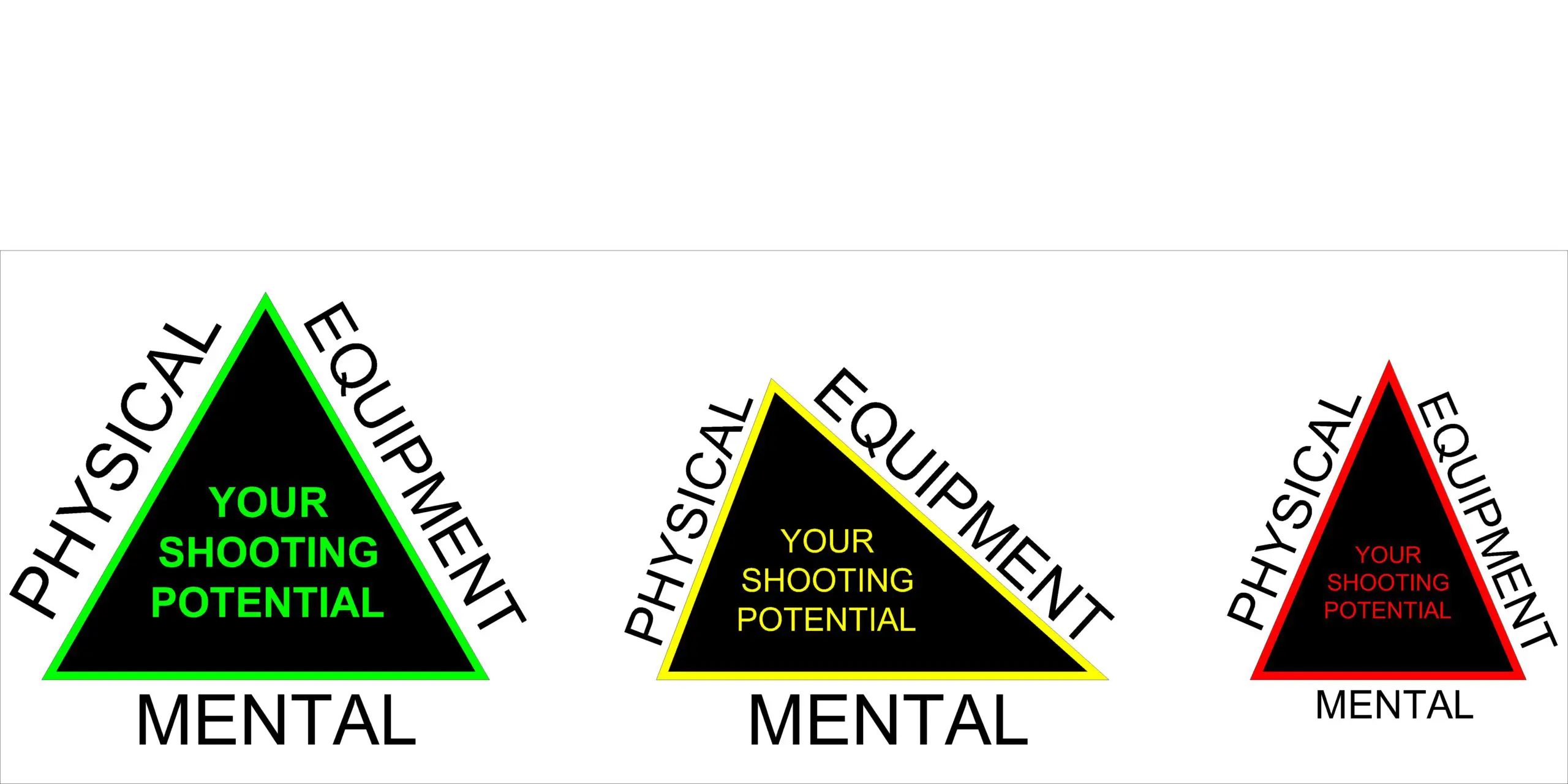
Each of these aspects are individually important, but there is also a synergistic effect that relies on their balance, which makes the sum of the individual parts greater or lesser than the whole. If we chart our three fundamental shooting elements as sides of a triangle, your shooting potential is represented by the area inside. The area is maximized - and your shooting is at its best - when the sides are balanced. Whenever a side is shorter than another, the area of the triangle is reduced.
Maintaining confidence can help you perform better under pressure. On the flip side, if doubts arise from lack of practice and your bow’s questionable tune, your confidence will take a hit also. Problems with equipment and lack of practice cause your performance triangle to shrink from all sides like a deflating balloon.
Mental prep is the least talked about factor in bowhunting success because we can’t see it, measure it, buy it, or use an Allen wrench to tighten it. We can’t even look to the best shooter around to see if we’re doing it right.
I’ve written about nearly every aspect of shooting form, practice routines, and equipment tuning in at least a dozen articles. There is no shortage of info out there to help you address these more tangible aspects of shooting. My goal here is to help you prepare better mentally because that’s where you can make the biggest impact on your shooting and bowhunting success.
A balance between mental focus and fluidity is crucial for making cold-bore hunting shots. In target archery, you train to block everything out of your mind except the target and your shot process. Using that level of focus made my shots a machine-like process when I was bowhunting also. On most shots, things went smoothly…range, shoot, dead animal. But if I was already “in the zone” ready for the shot, or at full-draw looking through the peep, and something changed, the results were hit and miss...
Everybody Hates Kickers
Bowhunters need the mind of a quarterback, not the kicker. Nothing against kickers, but the best QB’s can read and process all three levels of a defense in motion while keeping their eyes downfield. They “feel” the pass rush and instinctively step up to avoid pressure when necessary. They see the field and anticipate who will come open before the receiver even makes his cut. Amid all the chaos, they instinctively deliver a precision pass that hits their target right in the lungs.
In contrast, kickers have a single-minded focus that blocks out every distraction from the crowd and the field so they can focus 100% on making good contact with the ball. Have you ever seen a kicker pick up a bad snap and do something good with it? That’s what most bowhunters feel like the first time they have a shot at a big buck or react to something unexpected during a shot opportunity.
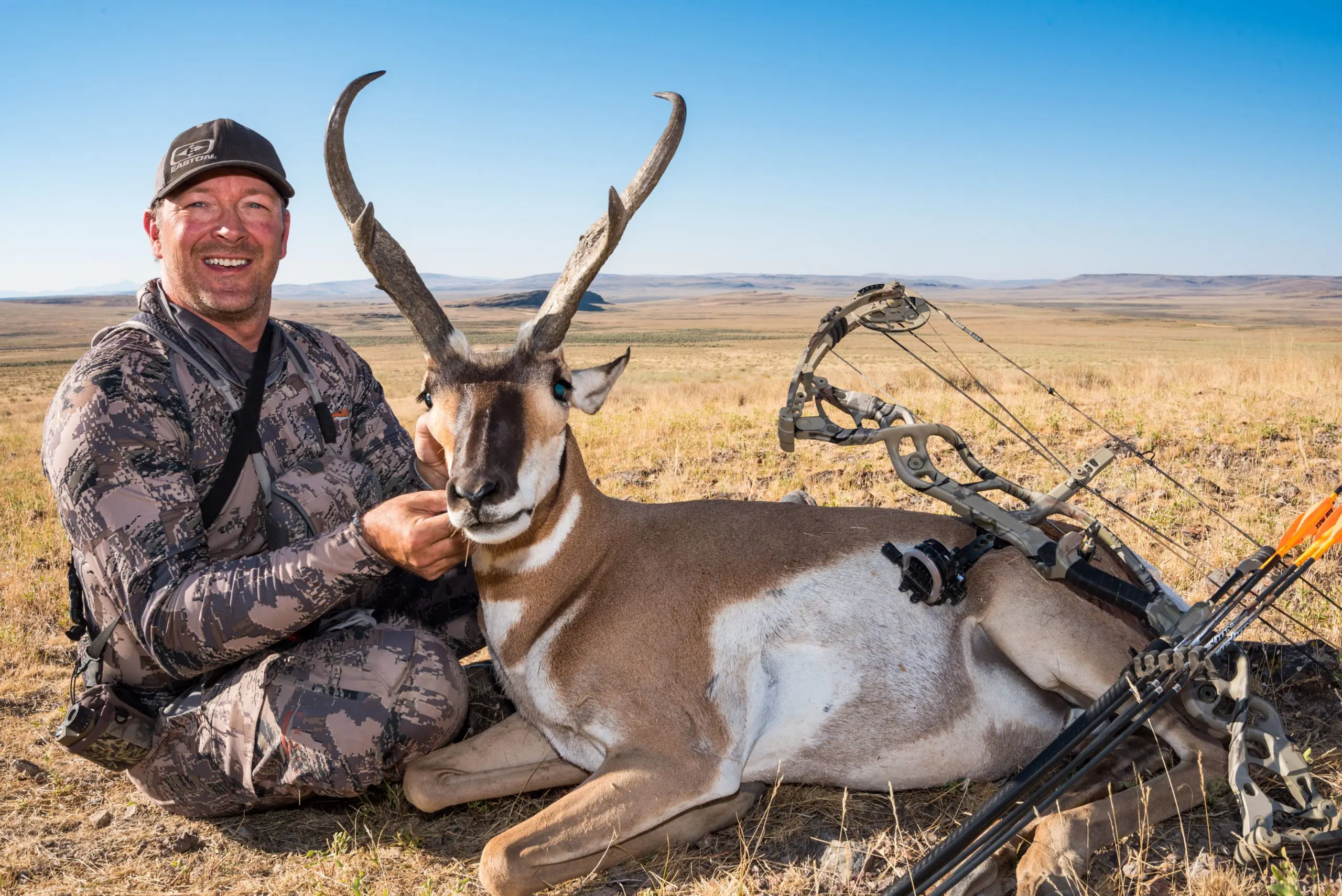
You don’t have to make an amazing shot to hit the vitals of a bull elk at 35 yards or a whitetail deer at half that. In most cases, below-average shooting will get the job done. Yet, how many good archers do you know that have blown those shots?
When I look back on 30 years of shots and opportunities, nearly all my screw-ups were due to some preventable issue or mental failure. Very seldom have I missed simply due to poor shooting. That realization is what led me down a different path with my practice over the past several years.
Prime Your Mind with a Pre-Shot Routine
Consistent shot execution requires a steady and stable mental flow. The best way to get into the same frame of mind for each arrow is to prepare mentally as part of your pre-shot routine. The goal of this step is to clear your mind and free up your concentration and focus on the task at hand. It will also have a calming effect on your nerves when you hit a familiar mental checkpoint. Your pre-shot routine will separate unwanted distractions, fear, and negative thoughts from your shot. You also need to engage your situational awareness so that you don’t get tunnel-vision and lose track of the details that can cause missed steaks!
If you look back through the bullet points at the head of this article or the QB analogy, you’ll note I emphasize gathering and processing information prior to a shot opportunity or throwing a pass. When your adrenaline is raging, your thoughts are scattered and poorly organized. It becomes far more difficult to gather and process information and maintain good judgment. The same types of mental errors are made when you are hyper-focused and have tunnel vision – except you shut out the information so there’s very little coming in to process. When something changes, it’s like waking up out of a dream and you don’t have a good sense of where you are or where things were before the shake-up.
I use this concise affirmation as a pre-shot “mental primer”: “I am relaxed, strong, and patient. My shot is automatic. I am confident, focused, and aware.”
I can feel tension drain from my shoulders, neck, and face as soon as I finish the word “relaxed” because that’s what I’ve trained myself to do by repeating the phrase and the process of relaxing thousands of times in practice sessions. After that, “strong” reminds me to pull strong against the back wall. “Patient” reminds me to wait for the shot and let it happen automatically. It reminds me to be “confident” in my aim and to “focus” intently on the spot the arrow will hit. Finally, it reminds me to be “aware” and stay connected to the situation and surroundings leading up to the shot.
I identified and recorded key elements of my form and shot process in my practice logs through the years because they consistently helped me shoot my best. I distilled those nuggets down into my pre-shot “mental primer”. I recite this in my head prior to every shot I take, whether bowhunting, shooting a tournament, or shooting hundreds of blank-bale shots with my eyes closed. My pre-shot primer is like an instruction set that pulls my focus together and guides my shot process so my cold-bore and pressure-packed bowhunting shots are consistent with my practice shots.
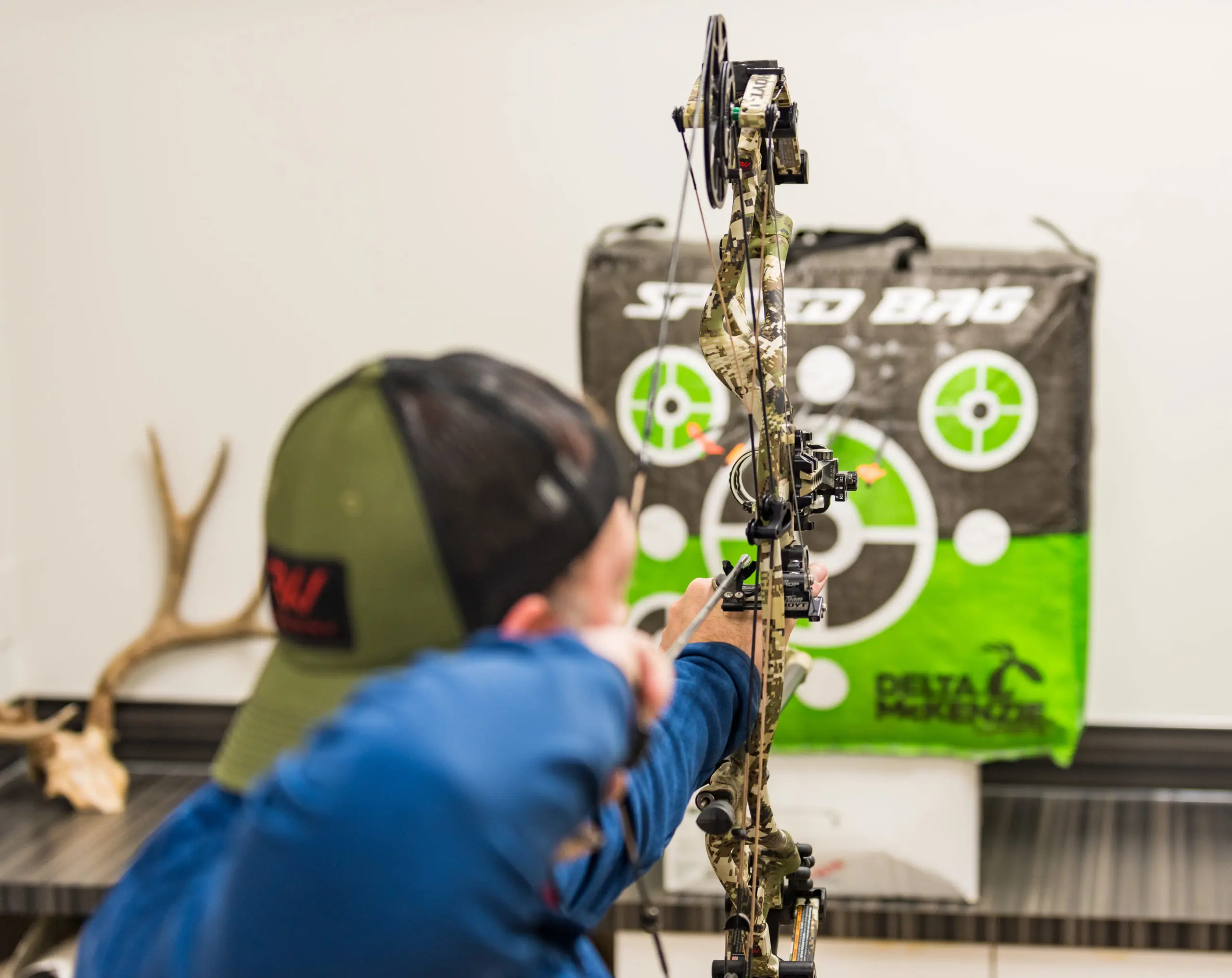
Use your logbook and what you already know about your shot to create a short phrase you can write down. Memorize and recite it to reset your mind, guide your shot process, focus your thoughts, and heighten your awareness before you shoot. Don’t be afraid to modify or tweak your pre-shot saying to find what works for you personally. Think about and visualize what the underlying things mean to your form and state of mind when you practice. Soon, they’ll start becoming an automatic part of your shot.
Some of these concepts might seem corny at first, but the mental primer and other recommendations I’ve laid out can be extremely effective tools when you commit and learn to use them every time you’re faced with adversity or pressure.
I’ve taken most of my cues and ideas from elite shooting coaches, gold medal-winning Olympic shooters, and sports psychologists and adapted them to bowhunting. I refocused my training on my cold-bore shot and modified my mental game to heighten situational awareness prior to and during the shot.
Since making these adjustments, my batting average on bowhunting shot opportunities has gone up substantially. I’ve eliminated many of the mental errors that caused misses in the past, despite shooting far less than when I was competing regularly. I hope you’ll latch onto something here that will help you improve your shooting, and most importantly, your bowhunting success.

